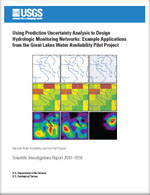The importance of monitoring networks for resource-management decisions is becoming more recognized, in both theory and application. Quantitative computer models provide a science-based framework to evaluate the efficacy and efficiency of existing and possible future monitoring networks. In the study described herein, two suites of tools were used to evaluate the worth of new data for specific predictions, which in turn can support efficient use of resources needed to construct a monitoring network. The approach evaluates the uncertainty of a model prediction and, by using linear propagation of uncertainty, estimates how much uncertainty could be reduced if the model were calibrated with addition information (increased a priori knowledge of parameter values or new observations). The theoretical underpinnings of the two suites of tools addressing this technique are compared, and their application to a hypothetical model based on a local model inset into the Great Lakes Water Availability Pilot model are described. Results show that meaningful guidance for monitoring network design can be obtained by using the methods explored. The validity of this guidance depends substantially on the parameterization as well; hence, parameterization must be considered not only when designing the parameter-estimation paradigm but also-importantly-when designing the prediction-uncertainty paradigm.


